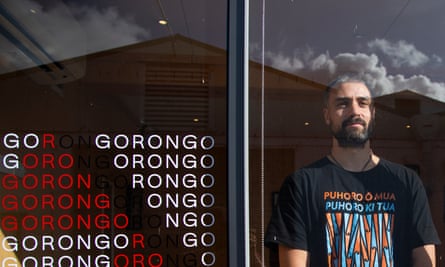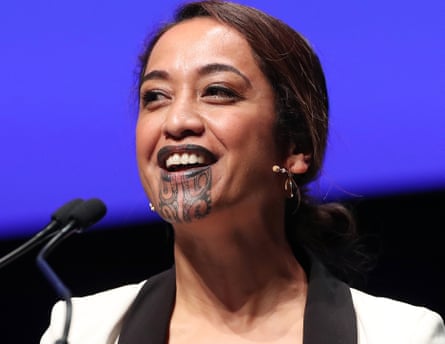Mokonui-ā-rangi Smith crouches on a woven mat, deep in concentration, the sound of tapping filling the room. Rhythmically, Smith hits a sharp bone comb to pierce the skin of the man in front of him, pushing in the pigment. The process is painstaking, meditative.
Over Smith’s shoulders two kuia – female elders – are visible, with lines of ink tracing their faces. They feature on two 1970 magazine covers encased in glass. The headline declares: “Māori Moko Fast Disappearing.”
“Few young people of today will have seen living examples of the Māori art of moko,” the caption reads. “The facial tattoo displayed by Māori warriors of the past has not been preserved as a custom among young men of Māori descent in recent generations.”
The portraits serve as a reminder of what was almost lost. But 50 years later, tā moko, the art of traditional Māori tattooing, is far from vanishing – it has undergone an unprecedented resurgence. Māori wearing moko kanohi (facial tattoos) and moko kauae (the marks worn on the chin by Māori women) are present in the halls of parliament, behind the anchor desks of the evening news, on elite sports fields and in judicial chambers. Practitioners say the current renaissance has been hard-won, and offers a way to reclaim and deeply connect to Māori culture.

Reclaiming identity
Smith, who works from a studio in west Auckland, says he had wanted to tattoo moko since he was a child. As he researched, however, he learned that many of the traditional tools and techniques had been lost by a generation who were forced – often violently – to assimilate. When the early generations of artists died, “they took it back to the darkness”, he says, and many practitioners were buried with their tools. “Then not long after, like 20 or 30 years after, that’s when the next generation started to go hard at researching and trying to revive it.”
The process of receiving moko is more than aesthetic, Smith says. It is a way to reclaim facets of Indigenous identity that were shamed, lost or attacked during colonisation. The designs can tell stories of a person’s whakapapa (ancestry), their achievements, their responsibilities and place within their family.

“You see wāhine [women] when they receive their kauae, and they break down,” he says. “Not because they are so blown away with how their face is changed – it’s nothing to do with the aesthetic. It’s all to do with shifting these huge, subtle doubts that have been put into us about who we are, what we are worth, our place in this world.”
Dale Dice, the man lying on the mat in front of him, is receiving a puhoro, which can cover the thighs, buttocks and lower back. When it is finished, around a quarter of his body surface will be marked. Dice says he decided to have his tā moko done after becoming both a father and the captain of a waka, the huge canoes Māori use to navigate the Pacific. “For me, it was starting to answer the questions like: what does it mean to be Māori, and who am I as a Māori? Now [that I’m in] both the role of a waka captain and being a father and bringing up my daughter, this is my answer to that question,” he says.

His voice breaks with emotion. “It’s pretty emotional, because you grow up Māori where all of these things have been tried to be suppressed – for years and years and years,” he says. “This informs me and informs others who I am and what I’m about.”
“A major part of this work is decolonising,” Smith says, “It’s a form of decolonising which starts with the body and it works its way in – and then turns around, and comes out.”

A symbol of pride and courage
While the practice is increasingly widespread, those bearing tā moko – particularly on their face – are still sometimes subject to discrimination or racist abuse. Bay of Plenty regional councillor Stacey Te Pohue Rose, who received his moko kanohi this year, told RNZ he had been subject to a barrage of racist abuse from the first week he got his tattoo. Stories of people who are insulted, abused or asked to leave businesses for moko are a semi-regular feature in New Zealand media. Last year, a petition was launched to formally prohibit moko as grounds for discrimination.
Facial moko are now borne by some of New Zealand’s most prominent figures and leaders, including foreign affairs minister Nanaia Mahuta and Māori party leaders Rawiri Waititi and Debbie Ngarewa Packer.

Earlier in the year, Oriini Kaipara became the first person with a moko kauae to host mainstream, prime-time television news.
“I’m of the generation who was told we wouldn’t amount to anything, that te reo would get us nowhere, that we would fail in life because we were being raised in total immersion Māori education. We – including our teachers, parents and supporters – were ridiculed and laughed at,” she says. “My purpose has always been to prove them wrong.”
She says wearing a moko kauae carries responsibility as pride: to have courage, show leadership, to nurture and give back to the culture.
“There is a kōrero [conversation] amongst the practitioners and receivers of moko kanohi; that we – Māori – are all born with our moko hidden beneath the veil that is our skin. It is up to the individual to decide whether or not they want their moko to be revealed to the world of light. Nonetheless, it exists. It is there.”
